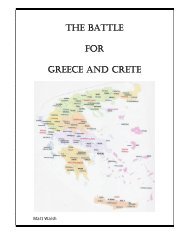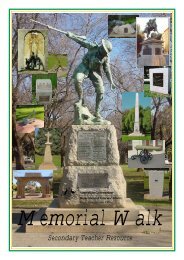Eastern Adelaide Teacher resource.pdf - Army Museum of South ...
Eastern Adelaide Teacher resource.pdf - Army Museum of South ...
Eastern Adelaide Teacher resource.pdf - Army Museum of South ...
You also want an ePaper? Increase the reach of your titles
YUMPU automatically turns print PDFs into web optimized ePapers that Google loves.
Concern about a German victory and its impact on Australia.<br />
Chance to show what Australians could do on the battlefield.<br />
Outrage at reported German atrocities in Belgium early in the war.<br />
To visit the motherland (Great Britain) and ancient civilisations.<br />
Chance to play a role on the world stage in the “war to end all wars”.<br />
The impact <strong>of</strong> recruiting drives and community pressure.<br />
Christian commitment.<br />
(7) Using the information recorded in Q(4) about the family name starting<br />
with the letter K, visit the Australian War Memorial website at<br />
www.awm.gov.au > Biographical Databases > Roll <strong>of</strong> Honour.<br />
Enter their surname and christian name (R is Reginald and S.C. is Sidney<br />
Clarence), select the First World War, 1914 –1918 and ‘click’ on search. Open<br />
the Circular Information and find out what three things were especially tragic<br />
about their deaths in respect to their relationship, place and time <strong>of</strong> death.<br />
Reginald and Sidney Clarence Kennedy were brothers. Both <strong>of</strong> them lost their lives at<br />
Ypres (Belgium) within a few days <strong>of</strong> each other on 28/9/17 and 4/10/17 respectively.<br />
(8) The names <strong>of</strong> M.J.R. and N.B.L. Crabb appear on<br />
the Magill Soldier’s Memorial.<br />
By accessing the Australian War Memorial Roll <strong>of</strong><br />
Honour find out if they were related.<br />
By looking at the notes in the Circular Information<br />
what happened to Murray on the 20 - 21<br />
September 1917?<br />
Murray John Rossiter and Norman Benjamin Lyndon Crabb were brothers.<br />
Murray was gassed on 20-21/9/1917.<br />
(9) Poison gas was a horrible weapon that was used during the First World<br />
War. During the period <strong>of</strong> its use on the Western Front, over 16,000<br />
Australians were gassed, with over 300 being killed by poison gas exposure.<br />
One particularly terrible form <strong>of</strong> chemical, which was first used in 1917,<br />
was known as “Mustard Gas”. Find out about the effects and problems<br />
with its use.<br />
Mustard Gas<br />
Germany unveiled an enhanced form <strong>of</strong> gas weaponry, which became known as<br />
mustard gas, an almost odourless chemical which was contained in artillery shells,<br />
against the Russians at Riga in September 1917. The serious blisters it caused, both<br />
internally and externally, brought on several hours after exposure, distinguished<br />
mustard gas from other types <strong>of</strong> poison gas used during World War One. Protection<br />
against mustard gas proved more difficult than against either chlorine or phosgene gas<br />
which had been used previously in the war. The use <strong>of</strong> mustard gas - sometimes<br />
proved to have mixed benefits. While inflicting serious injury upon the enemy, the<br />
33











